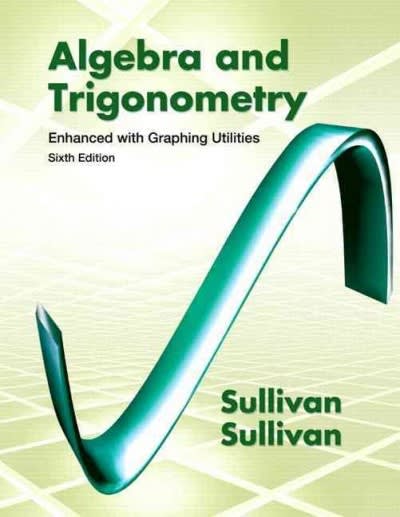Question
Student number = 991334 i. Take the first three digits of your student number and use them (in order) as the coefficients of a quadratic
Student number = 991334
i. Take the first three digits of your student number and use them (in order) as the coefficients of a quadratic expression of the form + + . For example, if your student number is 543210, the quadratic expression will look like 5 2 + 4 + 3. You may decide to make any of the coefficients negative if you like. For example, the above expression could be changed to 5 2 4 + 3. The resulting expression will be the numerator of your Rational Function.
ii. Take the last three digits of your student number and use them (in order) as the coefficients of a quadratic expression of the form + + . For example, if your student number is 543210, then this quadratic expression will look like 2 2 + 1 + 0, or 2 2 + . You may decide to make any of the coefficients negative if you like. The resulting expression will be the denominator of the Rational Function.
iii. Take the numerator you created in (i) and the denominator you created in (ii) and put them together to make your Rational Function, which you will call (). For the above example, the resulting function would be () = 5 4+3. If your student number has some 0 digits in it, you may have missing terms. 2 + This is not a problem, and you should be able to proceed through the remaining tasks normally.
1. Write the equation of the Rational Function you created according to the instructions listed above.
2. State the Domain of yourfunction.
3. Find and state the y-intercept of your function (if it has one). If there is none, explain whynot.
4. Determine any discontinuities of your function and classify them (holediscontinuity, infinite discontinuity, jump discontinuity, etc.). If you have a hole discontinuity at = then evaluate lim () to determine the co-ordinates. If your function has no discontinuities, make sure to fully demonstrate why not.
5. Find and state the x-intercepts of your function. If it has no x-intercepts, make sure to fully demonstrate why not.
6. Use lim + () and lim () to determine whether there is a horizontal asymptote. If there is a horizontal asymptote, then determine whether your function approaches from above or below as + and as . If your function has an Oblique Asymptote instead, then determine the equation of the Oblique Asymptote.
7. Determine () for your function and simplify the equation as much as possible. Make sure your derivative is expressed with positive exponents.
8. Determine all critical numbers for your function. If it has no critical numbers, make sure to fully demonstrate why not. If your equation cannot be solved algebraically, use technology to solve and make sure to indicate why it was necessary to do so.
9. Determine the intervals of increase and decrease for your function and state the co-ordinates of any local maxima or minima.
10. Determine () for your function and simplify the equation as much as possible. Make sure your derivative is expressed with positive exponents.
11. Determine all x-values where () = 0 or where () is undefined. If your equation cannot be solved algebraically, use technology to solve and make sure to indicate why it was necessary to do so.
12. Determine the intervals of concavity for your function and state the co-ordinates of any points of inflection.
Step by Step Solution
There are 3 Steps involved in it
Step: 1

Get Instant Access to Expert-Tailored Solutions
See step-by-step solutions with expert insights and AI powered tools for academic success
Step: 2

Step: 3

Ace Your Homework with AI
Get the answers you need in no time with our AI-driven, step-by-step assistance
Get Started


